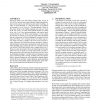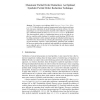556 search results - page 11 / 112 » An Abstract Reduction Model for Computer Security Risk |
IEEESP
2007
14 years 11 months ago
2007
igh level of abstraction and to provide broad oversight. In contrast, the goal of computer science security education is to provide the technicalexpertisetodevelopsecure software a...
75
Voted
NSPW
2006
ACM
15 years 5 months ago
2006
ACM
This paper details a true and striking paradigm shift: the use of E-Prime for (at least) user-centered security, organizational/enterprise security policies and informal security ...
ICDCS
2010
IEEE
15 years 3 months ago
2010
IEEE
—Internet users such as individuals and organizations are subject to different types of epidemic risks such as worms, viruses, and botnets. To reduce the probability of risk, an ...
77
Voted
ATVA
2009
Springer
15 years 6 months ago
2009
Springer
We present a data symmetry reduction approach for model temporal-epistemic logic. The technique abstracts the epistemic indistinguishably relation for the knowledge operators, and ...
98
Voted
CAV
2009
Springer
16 years 5 days ago
2009
Springer
Abstract. We present a new technique called Monotonic Partial Order Reduction (MPOR) that effectively combines dynamic partial order reduction with symbolic state space exploration...


